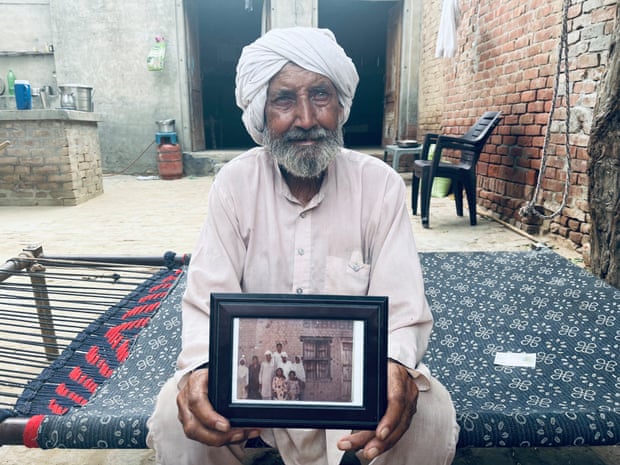‘Finally we are together’: partition’s broken families reunite after seven
It was an embrace that held 74 years of pain and longing. As Sikka Khan, 75, fell into the arms of his older brother Sadiq Khan, now in his 80s, the pair wept with simultaneous sorrow and joy. More than seven decades had passed since the brothers, torn apart by the horrors of partition, had seen each other. With Sikka in India and Sadiq in Pakistan, neither knew if the other was alive. Yet both had never stopped looking.
But on a crisp January afternoon this year, the pair were reunited along the border that had so devastatingly fractured their family. “Finally, we are together,” Sadiq told his brother, tears streaming down his face.
In Search of Lost Time:
Two brothers separated in 1947 during India-Pak partition reunite at Kartarpur Sahib after 74 years.
Video: @rsrobin1 pic.twitter.com/ebOop9g7Md
— Shah Faesal (@shahfaesal) January 12, 2022
n”,”url”:”https://twitter.com/shahfaesal/status/1481239406711570433″,”id”:”1481239406711570433″,”hasMedia”:false,”role”:”inline”,”isThirdPartyTracking”:false,”source”:”Twitter”,”elementId”:”0694390e-c466-4c89-b65e-9d586bdf465b”}}”/
It was 75 years ago, on 15 August 1947, that the subcontinent was divided down religious lines to become two independent countries, India and Pakistan. It was to be a bloody and bitter partition. After 300 years of official British presence, the key figures of Indian independence, Mahatma Gandhi and his protege and future prime minister Jawaharlal Nehru, envisaged a single, secular country. Muslim political leader Muhammad Ali Jinnah, however, argued for a separate state for Muslims, fearful of the implications of a Hindu-majority India.
As religious tensions were stoked, deadly riots broke out, targeting Hindus, then Muslims and then Sikhs. The British, keen to extricate themselves from India quickly, oversaw the drawing of a crude border that ruptured the Indian states of Punjab to the west and Bengal to the east, to form a disjointed Pakistan that angered all communities.

It instigated a mutual genocide on both sides of the new border. Whole villages were set alight, children were massacred, and an estimated 75,000 women were raped. In Punjab, the centre of the violence, pregnant women had babies cut from their bellies and trains full of refugees – Muslims fleeing Indian Punjab, Sikhs and Hindus fleeing western Pakistan – were ambushed and arrived at stations filled with silent bloody corpses.
The true death toll is still unknown, with estimates ranging from 200,000 up to 2 million, and it resulted in the biggest forced migration in history as more than 14 million people fled their homes. From that point onward, India and Pakistan were sworn enemies, split by a border that over decades would become increasingly fractious and impenetrable.

Families caught in the chaos and brutality were forced to leave everything behind and many were separated as they crossed into India or Pakistan. Though many tried desperately to find one other later,…
Read More: ‘Finally we are together’: partition’s broken families reunite after seven
